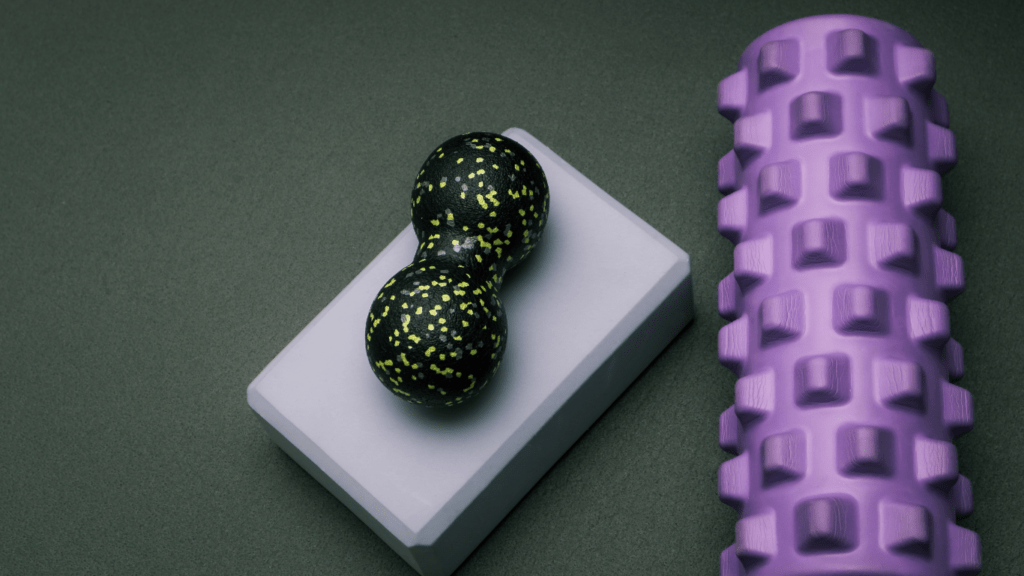Benefits of Foam Rolling
Foam rolling improves muscle recovery by breaking up scar tissue and adhesions. When muscles are tight, these adhesions can limit flexibility and cause pain. Regular foam rolling helps maintain optimal muscle function and prevent injuries.
Self-myofascial release provided by foam rollers increases blood flow. Enhanced circulation delivers more oxygen and nutrients to the muscles, aiding in faster recovery and reduced muscle soreness after intense workouts.
Foam rolling also enhances range of motion. By reducing muscle tightness, it ensures that joints move more freely, which can positively impact performance and reduce the risk of movement-related injuries.
Stress relief is another key benefit. Foam rolling stimulates pressure receptors in the nervous system, which helps reduce the perception of pain and promotes overall relaxation. This stress reduction can improve mental well-being and support consistent training habits.
Using foam rollers can save money on professional massages. While professional treatments are beneficial, they can be costly. Foam rolling allows individuals to achieve similar benefits at a fraction of the cost, making it an accessible recovery tool for everyone.
Key Features to Look For
Selecting the right foam roller is crucial for effective muscle recovery. Pay attention to these key features to maximize your foam rolling benefits.
Density
The roller’s density affects the intensity of your massage. Firmer rollers provide deeper pressure, breaking up tight muscle knots more effectively. Softer rollers offer a gentler massage, ideal for beginners or those with sensitive muscles. I recommend medium-density rollers for a balanced experience between firmness and comfort.
Surface Texture
Surface texture of the foam roller determines the type of massage you receive. Smooth rollers offer consistent pressure, suitable for overall muscle recovery. Textured rollers with ridges and knobs dig into muscles for a more targeted massage, aiding in breaking up adhesions. Choose textured surfaces if you seek deeper muscle stimulation.
Size and Shape
Size and shape influence the roller’s effectiveness on different muscle groups. Long rollers (36 inches) work well for large muscles like your back. Short rollers (12-24 inches) are more portable and target smaller areas such as:
- calves
- arms
Cylindrical rollers are versatile, while contoured shapes fit specific body parts better. Select a size and shape that aligns with your primary muscle recovery needs.
Top Foam Rollers on the Market

The market offers various foam rollers catering to different muscle recovery needs. Below are some of the top categories that stand out.
High-Density Foam Rollers
High-density foam rollers provide firm pressure to target tight muscle knots. Their durability allows them to maintain shape even with frequent use. For example, the AmazonBasics High-Density Round Foam Roller is popular for its affordability and effectiveness. Suitable for athletes needing deep tissue massage, these rollers offer consistent performance for rigorous sessions.
Grid Foam Rollers
Grid foam rollers feature a patterned surface mimicking a therapist’s hands. This design offers different pressure zones for a versatile massage. The TriggerPoint GRID Foam Roller, for instance, is renowned for its multi-density exterior and hollow core. It’s ideal for those needing targeted muscle relief, enhancing mobility, and improving overall workout performance.
Vibrating Foam Rollers
Vibrating foam rollers elevate muscle recovery by combining pressure with vibrations. These rollers stimulate blood flow and reduce muscle soreness more efficiently. The Hyperice Vyper 2.0, known for its powerful vibration settings and high-intensity relief, is a top choice. Suitable for those with high-intensity training routines, these rollers aid quicker recovery and greater muscle relaxation.
How to Use a Foam Roller for Muscle Recovery
Using a foam roller for muscle recovery involves proper techniques to ensure maximum benefits. I’ll cover basic methods and specific muscle group targeting.
Basic Techniques
Positioning: Place the foam roller on the ground. Sit or lie down so that the muscle group you’re targeting rests on the roller. Control the pressure with your body weight.
Rolling: Slowly roll back and forth over the muscle group. Aim for 20 to 30 seconds per spot. Move at about one inch per second to avoid straining the muscle.
Breathing: Maintain steady, deep breaths. Relax the muscle to enhance the effectiveness of the massage.
Pain points: When you hit a tender spot, pause and hold for 15 to 30 seconds. This helps release muscle tension and promotes recovery.
Targeting Specific Muscle Groups
- Quadriceps: Lie face down. Position the roller under your thighs. Use your forearms to roll from just above the knee to the hip.
- Hamstrings: Sit with the roller under your thighs. Use your hands behind you to lift your body and roll from just above the knees to the glutes.
- IT Band: Lie on one side. Place the roller under the outer thigh. Cross the top leg over and roll from just below the hip to above the knee.
- Calves: Sit with the roller under your calves. Lift your body with your hands. Roll from the ankles to under the knees.
- Upper Back: Lie on your back. Place the roller under the upper part. Cross your arms over your chest. Roll from the mid-back to the shoulders.
These steps ensure effective use of a foam roller for optimal muscle recovery and performance.
Tips for Maximizing Recovery with Foam Rolling
Choose the Right Foam Roller
Selecting an appropriate foam roller matters for effective recovery. Use soft-density rollers for beginners or sensitive areas like the lower back. Opt for firm-density rollers to target deeper muscle knots, ideal for experienced users or thicker muscles like quadriceps.
Roll Slowly
Roll at a controlled pace to maximize benefits. Slow, deliberate movements allow muscle fibers to release tension. Spend 1-2 minutes on each muscle group, adjusting pressure as necessary.
Focus on Breathing
Deep breathing enhances muscle relaxation and blood flow. Inhale deeply through the nose, exhale slowly through the mouth while rolling. This controlled breathing rhythm reduces discomfort and increases the effectiveness of foam rolling.
Target Trigger Points
Spend extra time on trigger points, or areas of increased tension. Apply pressure until discomfort subsides, typically between 10-30 seconds. This approach helps break down muscle knots and promotes flexibility.
Integrate Stretching
Combine foam rolling with stretching exercises for improved muscle recovery. Stretch each muscle group immediately after rolling to further enhance flexibility. Dynamic stretches are particularly effective for increasing range of motion.
Stay Consistent
Regular foam rolling improves muscle recovery. Integrate it into your daily routine, especially after workouts. Consistency aids in maintaining muscle health and reducing injury risk.
Listen to Your Body
Pay attention to your body’s signals. If you experience pain rather than discomfort, reduce pressure or take a break. Proper foam rolling should alleviate muscle tightness without causing injury.
Hydrate and Rest
Hydration aids muscle recovery. Drink water before and after foam rolling sessions to facilitate optimal muscle function and reduce soreness. Ensure adequate rest to allow muscles to heal and recover.
These tips enhance muscle recovery through effective foam rolling, optimizing performance and reducing injury risk.
 Albert Newman has been a dedicated contributor to Top Wellness Activity Hub, leveraging his extensive background in digital content creation to enrich the platform with engaging and valuable information. Known for his meticulous research and a knack for simplifying complex wellness topics, Albert focuses on producing content that is both informative and approachable. His articles cover a broad spectrum of wellness subjects, from healthy eating habits to the latest trends in yoga and fitness. Albert's ability to break down intricate health concepts into easily digestible insights has made the platform a trusted source for wellness advice.
Beyond his writing, Albert is also deeply involved in the content strategy and editorial planning of the platform. His collaborative approach ensures that each piece of content aligns with the platform’s mission to empower users on their wellness journey. Albert is always exploring innovative ways to engage readers, whether through interactive guides or personalized wellness tips. His commitment to creating high-quality, reader-centric content plays a significant role in the platform’s ongoing success.
Albert Newman has been a dedicated contributor to Top Wellness Activity Hub, leveraging his extensive background in digital content creation to enrich the platform with engaging and valuable information. Known for his meticulous research and a knack for simplifying complex wellness topics, Albert focuses on producing content that is both informative and approachable. His articles cover a broad spectrum of wellness subjects, from healthy eating habits to the latest trends in yoga and fitness. Albert's ability to break down intricate health concepts into easily digestible insights has made the platform a trusted source for wellness advice.
Beyond his writing, Albert is also deeply involved in the content strategy and editorial planning of the platform. His collaborative approach ensures that each piece of content aligns with the platform’s mission to empower users on their wellness journey. Albert is always exploring innovative ways to engage readers, whether through interactive guides or personalized wellness tips. His commitment to creating high-quality, reader-centric content plays a significant role in the platform’s ongoing success.